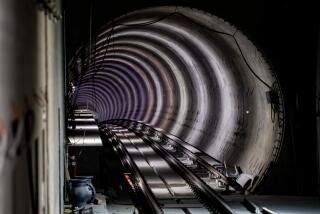Subway Snag: Underground Toxic Wastes
Southern California Rapid Transit District officials said Monday that more environmental problems--threatening increased costs and delays--may lie ahead for Metro Rail subway construction because of underground hazardous waste deposits near downtown’s Union Station.
The news came as a state panel approved a permit that requires RTD to clean up millions of gallons of foul-smelling ground water near Union Station before it can be dumped into the Los Angeles River. Cost of the cleanup will be about $10 million, officials said.
The problem soil, which has already delayed and added to the costs of another project--an $18-million busway--is located just north of the Santa Ana Freeway and east of Union Station, in an area where the subway and busway will cross.
Officials believe that the soil was contaminated by discharges from a coal gasification plant that operated on the site in the early 1900s. Among the chemicals discovered at depths reaching 30 feet is naphthalene, a toxic coal-tar derivative used in mothballs that can cause respiratory and neurological problems, according to state health officials.
RTD and state highway officials are studying the extent of the contamination in the area.
Jim Crawley, RTD’s chief Metro Rail engineer, said, “We know there is contaminated soil where we are going to be digging. . . . It does represent a toxic threat.” But Crawley said RTD will not know until studies are completed next month how much removal or treatment of the toxic material may delay excavation work and increase construction costs.
Crawley said the RTD, in addition to trying to define the extent of the problem, is exploring a variety of ways to deal with it, including removal, on-site treatment or sealing it off.
He predicted, however, that the problems would not delay the proposed 1992 opening of the first 4.4-mile Union Station-to-MacArthur Park segment of the subway.
So far, tests have indicated that an area of up to half an acre in the path of the subway may have toxic wastes, but officials say the full extent of the contamination is not known. The effect on the subway project is potentially more serious than the previously reported problems for the elevated busway. “Most of our work is above ground, so the increased costs won’t be substantial,” said John Reeves, chief of the construction branch of the state Department of Transportation.
But the subway route calls for digging through the material. The problem area lies in ground on a section of proposed tunnel connecting the system’s maintenance yard and the passenger terminal below Union Station.
“There is a serious problem,” said Jim Smith of the toxic substance control division of the state Health Department. “We really do need to know more about the extent of the contamination before we can get a handle on it.”
Smith said high concentrations of the toxic materials have been found in some tests and, if it is to be excavated, RTD “will have to take very careful precautions, if for no other reason (than the material) is so noxious.”
On the smelly ground-water problem, RTD was granted a permit by the state Regional Water Quality Control Board to pump up to 40 million gallons a day into the Los Angeles River. The ground water, which must be extracted near Union Station so the subway tunnel can be built, will have to be treated to reduce high levels of hydrogen sulfide--a gas that emits a strong smell like rotten eggs.
Initially, the RTD, citing cost and schedule problems for the subway project, had sought a waiver permitting the dumping of the smelly water. But Crawley said RTD officials had agreed to treat the water when an initial $20-million cost estimate was reduced to about $10 million. Crawley said the additional funds are available because tunnel construction bids for that area have come in more than $15 million below estimates.
More to Read
Sign up for Essential California
The most important California stories and recommendations in your inbox every morning.
You may occasionally receive promotional content from the Los Angeles Times.










